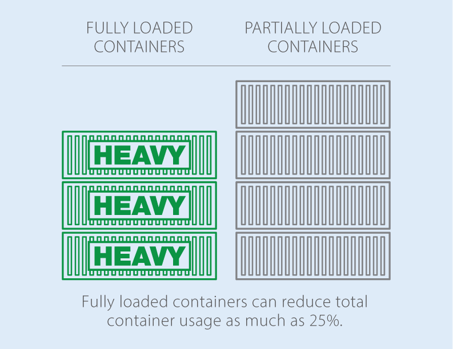One of the fastest and easiest solutions to sustainable shipping of ocean cargo is to maximize the payload of every container you ship and, in the process, ship 20% fewer containers. That's fewer ocean freight moves, fewer road moves, less handling, lower freight bills and, yes, a sizably reduced carbon footprint.
This sustainable shipping strategy applies mainly to shippers of heavyweight industrial freight, like metal, stone, and castings, as well as heavier consumer goods, like water and canned goods.
It’s a largely untapped opportunity, and here's why.
 Steamship lines promote the idea that you must limit container weight to 44,000 pounds or less to remain within “legal” limits once the container leaves the terminal and travels on DOT-regulated highways. So, shippers of heavy dense freight load containers only up to this weight limit, leaving a portion of the container empty.
Steamship lines promote the idea that you must limit container weight to 44,000 pounds or less to remain within “legal” limits once the container leaves the terminal and travels on DOT-regulated highways. So, shippers of heavy dense freight load containers only up to this weight limit, leaving a portion of the container empty.
The problem is that a 44,000-pound container weight limit simply doesn’t exist. The actual limit, depending on the State(s) traveled through, could be 10,000 pounds or more beyond the so-called legal limit.
The key to maximizing your container shipping payload is having a freight forwarder that has relationships with specialized trucking companies with the right equipment and permits to legally move heavy containers over the road.
That one, simple piece of the puzzle opens the door to a 20% reduction in ocean shipping costs for shippers of heavy goods. Yes, you'll pay a little more for the landside trucking. But that still leaves you with the lion's share of the 20% savings.
In the race to ship more sustainably, this is low-hanging fruit. Shippers are hesitant to jump on the bandwagon to support solutions like marine biofuels or zero emissions vehicles because they raise transport costs significantly in the short term.
Not so with a heavy container shipping strategy. You can save money and cut your carbon footprint immediately.
If this is not a strategy you've used before, there are freight forwarders that have specialized in handling heavy freight for decades. They have in-place networks of specialty carriers and they understand the permitting requirements to ensure your freight is street legal. You can drive the sustainable shipping strategy; they can manage the details.
Like we said, low-hanging fruit.
One Europe-to-USA tea importer was shipping 30–40 containers a month for $154 per metric ton. When it increased its max payload per container, its CY-to-door costs increased due to higher U.S. trucking costs. But its total port-to-door costs were reduced by $10,500 per month.
The savings are real. But an equally important advantage for your business is the huge reduction in carbon emissions – simply by shipping the same volume of freight using 25% fewer containers and fewer trucks.
Remember, steamship lines don’t charge by weight, they charge by container. The fewer you ship, the less you will pay. And the smaller your carbon footprint becomes through the following:
 |
Reduced Fuel Consumption: Fewer shipping containers means fewer trips, which, in turn, reduces the amount of fuel required for transportation. |
 |
Lower Emissions: Less fuel lowers greenhouse gas emissions, such as carbon dioxide (CO2), as well as other air pollutants. |
 |
Reduced Material Use: Manufacturing shipping containers, especially the larger ones, requires significant raw materials like steel, which has its own environmental impact. Fewer containers equates to less demand for new containers, reducing the need for raw material extraction and manufacturing processes. |
 |
Less Congestion: When fewer containers are in use, ports and transportation hubs are less congested. This results in more efficient operations and less idling time for vehicles, which, in turn, decreases fuel consumption and emissions. |
 |
Improved Use of Space: Optimizing container space leads to a more efficient use of cargo holds, both on ships and trucks. This reduces the overall physical space required for transportation, helping to preserve natural areas and mitigate urban sprawl. |
With corporate CSR programs ramping up, the pressure has never been greater on companies to demonstrate what they are doing to protect our environment. This heavyweight container strategy is a sustainable shipping strategy you can 1) implement quickly with no investment 2) communicate very simply and easily to your stakeholders because all you’re doing is shipping the same volume of freight in fewer containers.
But to get there you’ll need the right partner. Look for a freight forwarder that:
- Specializes in heavy freight
- Maintains strong relationships with carriers that have the needed equipment and permits
- Has experience across hundreds of heavyweight shippers and can manage the details of this shift toward sustainable shipping.
Heavyweight ocean shipping is not a new strategy and there are forwarders who can help. But most offer service only in one or two ports. A partner like I.C.E. Transport has carrier relationships near all major U.S. ports and can seamlessly manage your international door-to-door shipping.
If you ship heavy, dense products and want to explore the benefits of sustainable shipping of ocean containers through a heavy shipping strategy, contact I.C.E. Transport today.




